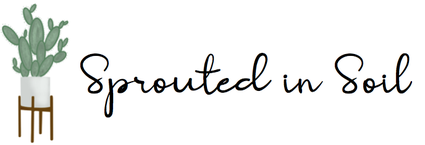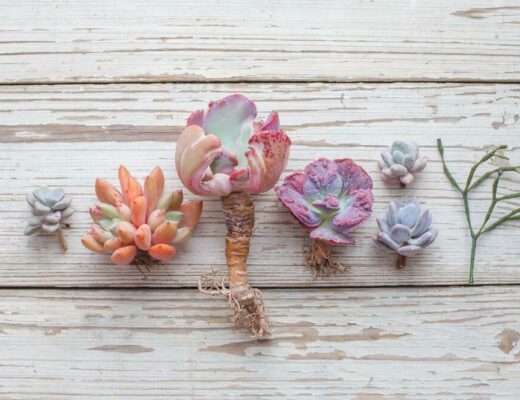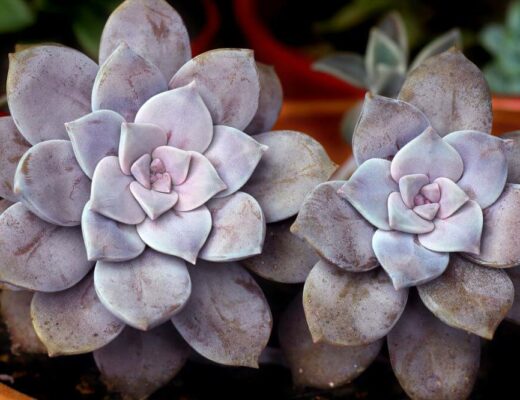The String of Hearts, or Ceropegia woodii, is a succulent-like plant native to the countries of Southern Africa. With marbled, green heart shaped leaves this plant has become an absolute favorite to grow indoors. Everyone is seemingly charmed by this delicate, cascading plant and it’s really no wonder. The String of Hearts is a stunning plant that easy to grow and just as easy to propagate.
Propagation can be used to create new plants or to make a single plant fuller! This post will discuss how to propagate a String of Hearts and all the different ways and techniques in which to do so!
The three main components of the plant used in the most successful techniques of String of Hearts propagation are the stems (either cut or not), roots and tubers. Using just these three elements, there are a handful of ways to produce new String of Hearts plants. First I want to talk about propagation with stems and stem cuttings, then I will introduce propagation using tubers. Lastly, I will wrap up this post by discussing propagation by dividing or separating roots.
Table of contents
Regardless of how you choose to propagate your String of Hearts, once you have rooted plantlets, you will want to start to care for them as you would a mature plant. Check out my post on String of Hearts care here!
String of Hearts Propagation with Stems
Using soil as the medium for propagation, both intact stems and stem cuttings can be grown into new plants! For all methods of propagation using soil, you will want to use a well draining soil, such as commercial succulent/cactus soil or a mixture that is homemade.
Stem Cuttings in Soil
String of Hearts cuttings are cuttings made from intact stems that are a couple inches long and have at least one pair of leaves and a node. A node is a point along a plant stem from which roots, petioles, and/or leaves grow from. Nodes are the most important thing when it comes to propagating a String of Hearts using stems!

Propagation by stem cuttings not only produces new plants, it can also be used to make the original plant fuller. Obviously if you add stem cuttings back into the original container, more stems will grow making the whole plant fuller from the base. Your original plant will also ultimately look fuller because at each cut end of the remaining stems, two new stems will grow!
- To start propagation using stem cuttings, you will need a healthy plant and sterile scissors or shears. Prepare a new container with fresh, well-draining soil.
- Cut stems from the mature plant that has at least one pair of leaves on it. This way you are sure to have included a node!
- Place each cutting into the soil after removing the bottom pair of leaves to expose the node. Be sure to completely cover each exposed node with soil.
- Position the stem cuttings in a warm area that receives bright but indirect sunlight throughout the day.
Expert Tip – To encourage fast root formation, you can place your container of stem cuttings on a heat mat. I suggest this for any propagation method, especially if you are doing it in the winter and have to position your new plants near a chilly window!
- To keep the soil moist, cover the soil with plastic that has a couple of air holes. Secure around the lip of the container.
- After a couple of weeks roots will have begun to form. To test for root formation, gently tug on each cutting for resistance.
- At this point, you can choose what to do with these new plantlets. Either transplant them back into the original container to make the mother plant more full or plant separately in new containers to make multiple new plants!
- Once transplanted, keep the soil moist for another week by misting daily. Then transition to caring for your plantlet as you would a mature String of Hearts.
Stem Cuttings in Water
To propagate String of Hearts cuttings in water you will want to follow the same steps as detailed above. This method allows you to monitor the root formation without disturbing the new plantlets by touching them.

- Using sterile scissors, cut stems from the mature plant. Be sure that each stem cutting has at least one pair of leaves.
- Remove the bottom most pair of leaves before placing it in a clear glass or plastic container. This exposes a growth node!
- Fill the container with room temperature water until the exposed node is submerged in water.
- Position in bright indirect light.
- Add new water when necessary to keep the bottom node submerged. Replace water when it begins to look cloudy or discolored.
- You will notice roots within one to three weeks. Once the roots are approximately ½ inch, transplant the cuttings into fresh, well-draining soil.
- To keep the soil moist, loosely cover the soil with plastic that has a couple of air holes for one week. After the first week, remove the plastic and transition to caring for your cuttings as you would a mature plant.
Stem Cuttings in Sphagnum Moss
Sphagnum moss is a perfect medium in which to propagate String of Hearts stem cuttings. This is because the moss provides the cuttings with just the right amount of moisture while encouraging healthy soil roots to form.

- To propagate stem cuttings in sphagnum moss, you will want to cut stem cuttings from the mature plant. Leave all of the leaves attached to the stems.
- Fill a shallow container (like a kitchen tupperware) with pre-moistened sphagnum moss. Lay out the cuttings on top of the moss in neat rows.
- Tuck the String of Heart’s nodes into the sphagnum moss. Since the moss is spongy and loose, you can usually just use the moss itself to secure the nodes. If not, you can use bobby pins or paperclips to ensure the nodes stay in contact with the moss.
- Mist daily and cover the container with plastic wrap with a few air holes.
- Position in bright, indirect sunlight. You will notice roots forming within one to three weeks. Once the roots are approximately ½ inch long, transplant into fresh, well-draining cactus/succulent soil!
Looping Intact Stems Back Into Container
With this method, we are solely looking to make one plant look more full without cutting anything! Choose a handful of healthy stems and coil each stem completely back into the original container. Again there is no cutting involved and you don’t have to remove any leaves.
Ensure that each node (a node is where a pair of leaves come together) is in contact with the soil by securing it with a loosely placed bobby pin or paperclip.
Because you are looping the plant back on itself, you won’t want to overwater your mature plant by keeping it as moist as you would stem cuttings. Water your String of Hearts as you normally would, when the top three inches of soil are dry. To add a bit more moisture to encourage root growth, mist the top of the soil lightly every couple of days.
Keep the plant in a bright area of your house but out of direct sunlight. New roots will grow from each node that is in contact with the soil, adding additional stems and fullness to your plant!
The Butterfly Method
This method is still technically utilizing a stem cutting, but instead of using just the end of one stem, you divide a stem cutting into multiple pieces to create a handful of small cuttings. This will give you more new plants from less original plant material!
- Using sterilized scissors, make a cut ⅛ inch above and below the point where a pair of leaves meets the stem, also known as the node. You can make as many cuts as there are pairs of leaves on a stem.

- Place the cuttings in a prepared container with pre-moistened, well draining soil or pre-moistened sphagnum moss. Position the cuttings approximately ½ inch apart. Ensure that both sides of the cut stems are touching the soil.
- Cover the container with a plastic bag or saran wrap with a couple air holes to allow for ventilation. Keep soil moist by misting daily or as needed. As always, keep in a well lit area!
- Within a week or two you should note new growth. After a couple of months you will have vines that have grown a couple of inches and produced new leaves!
String of Hearts Propagation with Tubers
What the heck are tubers? Tubers are thickened, underground portions of modified stems that provide and store nutrients for the plant. The String of Hearts plant, once mature, forms aerial tubers on the vines and we can use those to propagate!
As your plant matures, you may notice bulbous, round growths all along the cascading stems. These are tubers and can be used for propagation. Let’s learn how!

- Prepare multiple, small containers filled with cactus or succulent soil and position them close to the original plant’s container.
- Without cutting anything, lay out the vines containing tubers into each of these containers so each tuber is touching soil. You can have multiple tubers on vines coiled into one pot.
- Push the tubers into the soil so they are half buried.
- Cover each container with a plastic wrap with a couple air holes to keep soil moist.
- Within a few weeks to a month, you should note new growth from the tubers. At this time you can separate each area of new growth from the original plant and each other.
- You can choose to either keep it in the propagation pots or transplant into a new, permanent container. I suggest keeping the soil consistently, slightly moist for the next couple weeks than transition to more mature String of Hearts care.
String of Hearts Propagation by Division
Propagation by root division is very easy. I wouldn’t even call it true propagation as you are just splitting a plant apart, but it gives us new plants just like the other methods so why not include it!

The String of Hearts plant has a tangled ball of delicate roots that twist and turn below the soil. Numerous stems emerge from this single root ball and can be separated off into new plantlets. Since mature soil roots have already formed, you will already have a fully formed plant once transplanted.
- Gently remove your String of Hearts plant from its container and brush away excess soil to easily visualize the roots.
- You can choose to separate individual vines/stems with attached roots or keep multiple stems together attached by shared roots. Either way, using your fingers or sterilized scissors as needed, separate the roots from each other.
- Plant each rooted section into a new container with the appropriate well-draining soil.
- Keep soil moist by misting daily for a week and position the plants in bright, indirect sunlight.
- After a week, begin to care for the plantlets as you would a mature String of Hearts plant to avoid overwatering and root rot.
Are There Other Ways to Propagate?
The answer is yes, there are. You can choose to propagate from seeds and get a new plant. You can also technically propagate a String of Hearts plant from a single leaf but this is extremely unreliable and, if successful, takes a long time.
To propagate a String of Hearts from seeds you first need, obviously, seeds. I don’t know of any place that sells seeds so you would have to gather the seeds from a mature plant. For seeds to form, your String of Hearts first has to bloom. Then the flowers have to be pollinated. Once pollinated, seed pods will form in a pair opposite each other along the stem. Seeds can then be collected from these seed pods and planted into well-draining soil.

Once planted, the soil needs to be kept consistently moist. Just like with all other methods, I suggest covering the soil with plastic wrap with a couple air holes punched in it to create a humid environment.
Here comes the waiting part. Germination and the subsequent growth of a new plant can take a long, long time. So for the work that goes into forming a seed and then waiting for it to sprout, I don’t think this method of propagation is worth it.
Using a single leaf for propagation can take an interminable amount of time if it even produces a new plant. I suggest not even trying or you will just be frustrated!
Conclusion
I know I just gave you a handful of different ways to successfully propagate a String of Hearts plant. Don’t be discouraged if one way doesn’t work well for you because luckily there are a number of different ways to try. See which one works for you!
My final tip is to use lots of plant material especially the first couple times because this gives you a higher rate of success! Now go out and propagate!!




